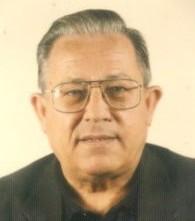Daniel Comboni
Misjonarze Kombonianie
Obszar instytucjonalny
Inne linki
Newsletter
In Pace Christi
Mele Riccardo
Riccardo Mele was a Liceo student in his native Sicily when, aged nineteen, he entered the Comboni novitiate at Florence (1947), determined to follow the path to the priesthood (1956) and the mission. He was one of the very first Combonis to go to Spain as a young, newly-ordained priest.
Fr. Riccardo was soon given the post of recruiter, as the vocations promoters were then called. His job was to go around the parishes, schools and families seeking aspirants for the seminary at Corella. He immediately began to visit some Basque towns around San Sebastián but soon realised that the nearby diocese of Pamplona was a more fruitful territory for vocations so he was happy to move to a temporary residence in Corella, while waiting for the new house that was being built to be completed.
It was during those years in Corella that I came to know him: Riccardo was jovial, enthusiastic and generous; he had learned Spanish well, even the local variations used on the banks of the Ebro River. With his Fiat 600, for five years, he visited the parishes of the nearby provinces of Navarra, Rioja, Soria, and Zaragoza…, asking to speak to the children in the schools and parishes. Among the fruits of those vocational sorties were Fathers Javier Sagasti, Felipe Castrejana, José Istúriz and his brother Miguel Ángel († 1991)… On Sundays he often helped with Mission Appeals and ministry in the parishes and so contributing significantly to the economy of the community.
He was then appointed for a further period of five years to San Sebastián where, for some years now, Aguiluchos had been published, giving new energy to that work, combining editorship with distribution, going personally to the schools.
In 1968 he left Spain for a period of aggiornamento in Italy before his new appointment to Latin America where he worked for almost 25 years. After a short period in Ecuador, in 1972 he began to serve in Peru, his main field of mission work. In those times, the outskirts of the capital and other cities were growing enormously due to the influx of entire villages of people from the Andes seeking a better life and, during the eighties, especially, to escape the cruelties of the terrorist movements of Sendero Luminoso and MRTA (Revolutionary Movement Tupac Amaru).
In view of the urgent pastoral needs, in 1970, the Comboni Missionaries founded the parish of “Los 12 Apóstoles” in Chorrillos, in the south-west periphery of Lima, in the direction of the Pacific Ocean where new “Pueblos jóvenes” were continually springing up. The first parish priest was Fr. Mario Mazzoni, soon to be helped by Fr. Riccardo Mele, who, after some years, was asked to continue the work.
Great pastoral needs required a response with innovative pastoral methods; the missionaries Mario, Riccardo and others could see no better way forward than to adopt the NIP Plan (New Parish Image) which took its inspiration from the Better World Movement launched by the Jesuit Fr. Riccardo Lombardi in the aftermath of the War, for the purpose of rebuilding, amid the ruins of the world conflict, new human, family, social and religious textures. The new parish was to be a centre of evangelisation and human and religious formation of the parishioners and to develop as a communion of small communities; people needed to grow within the groups and the groups were to be integrated into the larger community; leaders would be found and formed, responsibilities would be shared, involving as many people as possible; the autonomy of the small communities would be protected but within the unity of the whole parish.
The Plan was promising but the methodology and the planning of activities required from the priests total dedication, a constant presence, transparency in relations, the ability to animate and, above all, continual and diversified sessions of formation at various levels. It was here that Fr. Riccardo reached his zenith; he gave the best of himself for the life of the parish in those years and saw it grow to maturity until the time came to hand over the better organised and developed part to the local clergy.
The small communities grew and the work increased; fortunately, confreres from other Lima communities helped with ministry in the various chapels. I remember how Fr. Riccardo was always very grateful when I could help him with Sunday Mass or in other ways. He was a tireless worker and a good organiser and bore the brunt of the work; he was strict in his poverty and kept exact accounts. Sometimes confreres considered him too centralising but this was understandable considering the responsibilities he bore. After a period in Lima, Fr. Mele was assigned to the Comboni community of Chile where he stayed for another period of five years (1987-1993), giving renewed impulse to the missionary information bulletin that was sent out to friends and benefactors. He then returned for good to Italy.
(Fr. Romeo Ballan, mccj).
Da Mccj Bulletin n. 274 suppl. In Memoriam, gennaio 2018, p. 1-6.

